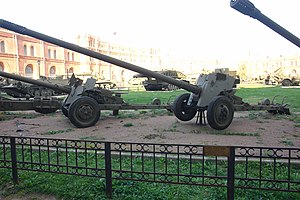| 2A19 (T-12) 100 mm anti-tank gun | |
|---|---|
 T-12 displayed in the Artillery Museum in Saint Petersburg, Russia. | |
| Type | Anti-tank gun |
| Place of origin | Soviet Union |
| Service history | |
| In service | 1961–present |
| Used by | See Operators |
| Wars | See Combat history |
| Specifications | |
| Mass | 2,750 kg (6,060 lb) |
| Length | 9.16 m (30 ft 1 in)[1] |
| Barrel length | 6.3 m (20 ft 8 in) 63 calibers[1] |
| Width | 1.795 m (5 ft 11 in) |
| Height | 1.565 m (5 ft 2 in) |
| Crew | 6[1] |
| Shell | Fixed QF 100 × 910 mmR (R/147mm) |
| Caliber | 100 millimetres (3.9 in) |
| Recoil | Hydro-pneumatic |
| Carriage | Transport: Ural-375D (6×6) On road: 60 km/h (37 mph) Off road: 15 km/h (9 mph) |
| Elevation | −10° to +20°[1] |
| Traverse | 27° left or right |
| Rate of fire | 14 rpm (max possible) 10 rpm (max likely) 4 to 6 rpm (typical) |
| Muzzle velocity | See Ammunition |
| Maximum firing range | See Ammunition |
2A19 or T-12 is a Soviet-designed 100-mm anti-tank gun. It was the first anti-tank gun to adopt a smoothbore barrel, and to introduce modern armor piercing shot, like the APFSDS. It uses long projectiles that are more powerful than its caliber suggests. The T-12 served as the primary towed anti-tank artillery in the Soviet and Bulgarian armies from the early 1960s to the late 1980s.